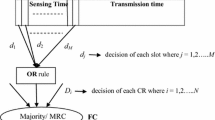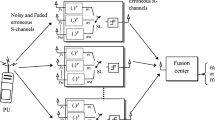Abstract
In this paper a novel multiple-user cooperative spectrum sensing scheme (MCSS) based on hybrid relay is proposed to achieve the spatial diversity gain in detection of the primary user (PU) in a cognitive radio (CR) network. A practically important case where co-channel interference signals are present at the network is considered for the analysis. Closed-form expressions of detection probability \((\hbox {P}_{\mathrm{d}})\) and false alarm probability \((\alpha )\) for the proposed adaptive decode-and-forward based multiple-user cooperative spectrum sensing scheme (ADF-MCSS) using energy detector over Rayleigh fading sensing channels is derived in presence of co-channel interference at the secondary user which is far away from the PU. Further we extend the concept of two user amplify-and-forward (AF) and decode-and-forward (DF) cooperative spectrum sensing schemes in multiple-user scenario (i.e. AF-MCSS and DF-MCSS) over Rayleigh fading channels when the secondary user (which is far away from PU) is affected by interference. Closed-form expressions of AF-MCSS and DF-MCSS schemes over a Rayleigh fading channels are also evaluated and compared with that of proposed ADF-MCSS in presence of interference signals at the secondary user. Further the performance analysis of AF-MCSS, DF-MCSS and ADF-MCSS schemes are compared with the existing non-cooperative spectrum sensing schemes in presence of interference at the secondary user. Our analysis is validated by numerical and simulation results for multiple-user CR network. The impact of number of cooperative relays, SNR in sensing channel, energy of interference signal, false alarm on detection probability in proposed ADF, AF and DF schemes is shown.







Similar content being viewed by others
References
Haykin, S. (2005). Cognitive radio: Brain-empowered wireless communications. IEEE Journal on Selected Areas in Communications, 23, 201–220.
Peha, J. M. (2005). Approaches to spectrum sharing. IEEE Communications Magazine, 43(2), 10–12.
Devroye, N., Mitran, P., Shin, O.-S., Ochiai, H., Tarokh, V. (2007). Cooperation and cognition in wireless networks. SK Telecom Review, special issue on 4G Spectrum and System Engineering issues, February 2007.
Ganesan, G., & Li, Y. G. (2007). Cooperative spectrum sensing in cognitive radio, Part I: Two user networks. IEEE Transactions on Wireless Communications, 6, 2204–2213.
Jovicic, A., & Viswanath, P. (2009). Cognitive radio: An information-theoretic perspective. IEEE Transactions on Information Theory, 55(9), 3945.
Simeone, O., Bar-Ness, Y., & Spagnolini, U. (2007). Stable throughput of cognitive radios with and without relaying capacity. IEEE Transactions on Communications, 55(12), 2351–2360.
Ghasemi, A., Sousa, E. S. (2005). Collaborative spectrum sensing for opportunistic access in fading environments. In Proceedings of 1st IEEE Symposium New Frontiers in Dynamic Spectrum Access Networks (pp. 131–136). USA: Baltimore.
Atapattu, S., Tellambura, C., & Jiang, H. (2009). Relay based cooperative spectrum sensing in cognitive radio networks. In Proceedings of Global Telecommunications Conference (GLOBECOM 2009) (pp. 1–5). HI: Honolulu.
Zou, M., Zhao, C., Shen, B., & Kwak, K. (2008). Decode-and-forward protocol based cooperative spectrum sensing in cognitive radio. In Third International Conference on Convergence and Hybrid Information Technology (Vol. 1, pp. 902–907).
Ganesan, G., & Li, Y. G. (2005). Agility improvementthrough cooperative diversity in cognitive radio. In Proceedings of IEEE Global Telecommunications Conference (GLOBECOM 2005) (pp. 2505–2509). Missouri, USA: St Louis.
Ganesan, G., & Li, Y. G. (2007). Cooperative spectrum sensing in cognitive radio, Part I: Two user networks. IEEE Transactions on WirelessCommunications, 6, 2204–2213.
Ganesan, G., & Li, Y. G. (2007). Cooperative spectrum sensing in cognitive radio, part II : Multiuser networks. IEEE Transactions on Wireless Communications, 6(6), 2214–2222.
Laneman, J. N., & Tse, D. N. C. (2004). Cooperative diversity in wireless networks: Efficient protocols and outage behavior. IEEE Transactions on Information Theory, 50, 3062–3080.
Zhu, Jia, Zheng, Baoyu (2009). Detection probability analysis of cooperative spectrum Sensing in Rayleigh fading channels. In Eigth IEEE/ACIS International Conference on Computer and Information Science (pp. 177–182). Shanghai. doi:10.1109/ICIS.2009.87.
Zhu, J., Zheng, B., & YuLong, Z. (2009). Detection time analysis for the multi-user cooperative spectrum sensing scheme in coginitive radio network. Science in China Series F: Information Sciences, 52(10), 1915–1925. doi:10.1007/s11432-009-0166-x.
Proakis, J. G. (2001). Digital communication (4th ed.). Boston: McGraw Hill.
Author information
Authors and Affiliations
Corresponding author
Rights and permissions
About this article
Cite this article
De, C.K., Kundu, S. Adaptive Decode-and-Forward Protocol Based Cooperative Spectrum Sensing in Cognitive Radio with Interference at the Secondary Users. Wireless Pers Commun 79, 1417–1434 (2014). https://doi.org/10.1007/s11277-014-1937-2
Published:
Issue Date:
DOI: https://doi.org/10.1007/s11277-014-1937-2




